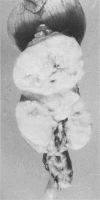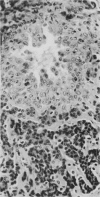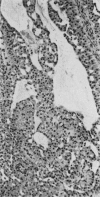Abstract
A case of metastatic prostatic adenocarcinoma with concurrent Sertoli cell tumor is presented in an old, miniature Schnauzer dog. The prostatic neoplasm was highly anaplastic and had metastasized widely. Clinical signs were compatible with increased estrogen production. It is interesting to note that the prostatic carcinoma, usually considered to be androgen dependent, developed and metastasized, despite the presence of apparently increased estrogen levels.
Full text
PDF



Images in this article
Selected References
These references are in PubMed. This may not be the complete list of references from this article.
- Chaisiri N., Valotaire Y., Evans B. A., Pierrepoint C. G. Demonstration of a cytoplasmic receptor protein for oestrogen in the canine prostate gland. J Endocrinol. 1978 Jul;78(1):131–139. doi: 10.1677/joe.0.0780131. [DOI] [PubMed] [Google Scholar]
- Comhaire F., Mattheeuws D., Vermeulen A. Testosterone and oestradiol in dogs with testicular tumours. Acta Endocrinol (Copenh) 1974 Oct;77(2):408–416. doi: 10.1530/acta.0.0770408. [DOI] [PubMed] [Google Scholar]
- Evans C. R., Pierrepoint C. G. Demonstration of a specific cytosol receptor in the normal and hyperplastic canine prostate for 5alpha-androstane-3alpha, 17alpha-diol. J Endocrinol. 1975 Mar;64(3):539–548. [PubMed] [Google Scholar]
- Hall W. C., Nielsen S. W., McEntee K. Tumours of the prostate and penis. Bull World Health Organ. 1976;53(2-3):247–256. [PMC free article] [PubMed] [Google Scholar]
- Jacobi G. H., Wilson J. D. The formation of 5alpha-androstane-3alpha, 17beta-diol by dog prostate. Endocrinology. 1976 Aug;99(2):602–610. doi: 10.1210/endo-99-2-602. [DOI] [PubMed] [Google Scholar]
- Leav I., Cavazos L. F., Ofner P. Fine structure and C19-steroid metabolism of spontaneous adenocarcinoma of the canine prostate. J Natl Cancer Inst. 1974 Mar;52(3):789–804. doi: 10.1093/jnci/52.3.789. [DOI] [PubMed] [Google Scholar]
- Leav I., Ling G. V. Adenocarcinoma of the canine prostate. Cancer. 1968 Dec;22(6):1329–1345. doi: 10.1002/1097-0142(196811)22:6<1329::aid-cncr2820220633>3.0.co;2-x. [DOI] [PubMed] [Google Scholar]
- O'SHEA J. D. STUDIES ON THE CANINE PROSTATE GLAND. II. PROSTATIC NEOPLASMS. J Comp Pathol. 1963 Jul;73:244–252. doi: 10.1016/s0368-1742(63)80027-2. [DOI] [PubMed] [Google Scholar]
- Pierrepoint C. G., Galley J. M., Griffiths K., Grant J. K. Steroid metabolism of a Sertoli cell tumour of the testis of a dog with feminization and alopecia and of the normal canine testis. J Endocrinol. 1967 May;38(1):61–70. doi: 10.1677/joe.0.0380061. [DOI] [PubMed] [Google Scholar]
- Shain S. A., Boesel R. W. Androgen receptor content of the normal and hyperplastic canine prostate. J Clin Invest. 1978 Mar;61(3):654–660. doi: 10.1172/JCI108977. [DOI] [PMC free article] [PubMed] [Google Scholar]
- Sinowatz F., Chandler J. A., Pierrepoint C. G. Ultrastructural studies on the effect of testosterone, 5alpha-dihydrotestosterone, and 5alpha-androstand-3alpha,17alpha-diol on the canine prostate cultured in vitro. J Ultrastruct Res. 1977 Jul;60(1):1–11. doi: 10.1016/s0022-5320(77)80035-x. [DOI] [PubMed] [Google Scholar]
- Taylor P. A. Prostatic adenocarcinoma in a dog and a summary of ten cases. Can Vet J. 1973 Jul;14(7):162–166. [PMC free article] [PubMed] [Google Scholar]
- Walsh P. C., Wilson J. D. The induction of prostatic hypertrophy in the dog with androstanediol. J Clin Invest. 1976 Apr;57(4):1093–1097. doi: 10.1172/JCI108353. [DOI] [PMC free article] [PubMed] [Google Scholar]








